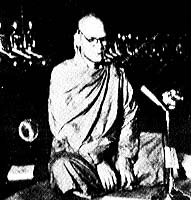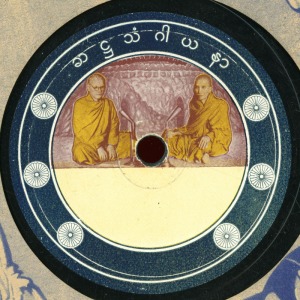One of the most compelling aspects of collecting world music 78s is the experience of dropping the needle and being surprised at what comes out of the speakers. I often have a pretty good idea of what to expect, but it’s the mysteries and surprises that keep me inspired! Here’s one that’s mysterious on several fronts.
As you can see, one side has a label with a picture of two monks and six characters written in Burmese across the top. The reverse side of the record is a white test pressing label. I bought the record thinking it would be Burmese Buddhist chanting. I’ve come across examples of Buddhist chants on 78 from other parts of Southeast Asia, but I was completely knocked out when I heard the music. It’s definitely not Burmese. After passing it around to a few ethnomusicolgists we quickly ruled out Burmese, Thai, Cambodian, Lao and Nepalese. The reverse side is completely different sounding, some kind of pop or Bollywood song, begging the question of why these two disparate tracks were coupled.
The only numbers on the record are in the dead wax, OMC 18780-TI on one side and OJE 27007-TI on the other. These numbers reveal the record was pressed by HMV, either as part of an HMV series or subsidiary, or possibly even a small independent label that used HMV simply as a pressing service, a common practice across Asia. One discographer thought the numbers dated it to about 1945, but further research suggests that may be incorrect.
I began to think that the monk label and the music were unrelated. Maybe the label was a mistake or added later. But when my friend Suwai translated the Burmese writing as “Sixth Buddhist Convention” I began to change my mind. The Sixth Buddhist Convention was a massive Buddhist gathering held in Burma in 1954, to mark the “completion of 2500 years of the Buddhist era (Buddha Jayanti).” Lasting 2 years, 2500 monks came from Sri Lanka, Thailand, Cambodia, Laos as well as other Buddhist countries of Asia to preserve and collect the teachings of Buddha in a specially built cave at the Kaba Aye Pagoda in Rangoon. Of course, I began to wonder, could this music have been recorded at the Convention, perhaps by a visiting delegation? I have yet to find any mention of musical recordings in connection with the Convention. Then again, maybe it really was recorded in 1945 and released for the Convention? Or maybe this was a test and the series was never actually produced?
I wondered who are the monks pictured on the label? Surely they must be well-known. Reading further about the event provided the answer. The Burmese monk Mahasi Sayadaw, famous for his work spreading the meditation practice Vipassana, was one of the main editors and organizers of the Convention. With a bit of googling I was able to find the very picture that was reproduced for the label.
I still have not determined what language is spoken in the short introduction to this record, despite help from the language hounds over at the Omniglot blog. It would be interesting to know what is being said. Maybe it would give us our final clue to determining where the music comes from?
Let’s see if some good ol’ internet crowd sourcing can answer any of these questions…readers?
**********************************UPDATE*****************************************
Well, that didn’t take too long!
A special thank you to the wonderful Tibetan musician Techung for confirming my suspicion that this is Tibetan music.
He writes:
“Yes, indeed. this an old recording from Lhasa, Tibet. The instruments are Dramyen, the long neck lute and Piwang, Tibetan fiddle. The song is titled “Soong la Emo Ri”. In fact I am starting to work on a recording of these types of songs in my next project. I will update on my website in the next few days.”
Check his site soon to hear his version.
How this recording is connected to the Sixth Buddhist Convention remains a mystery.


